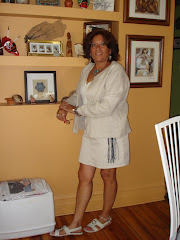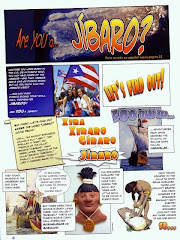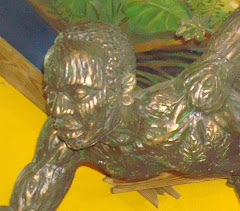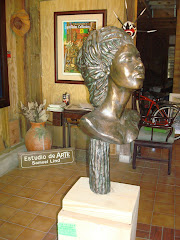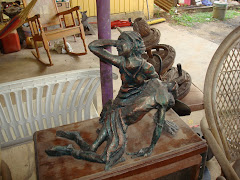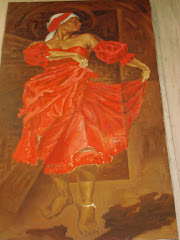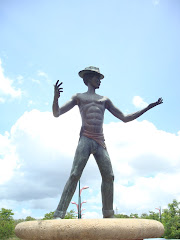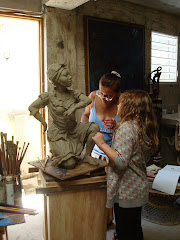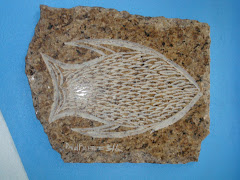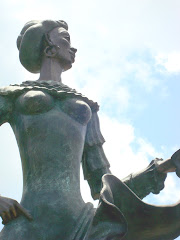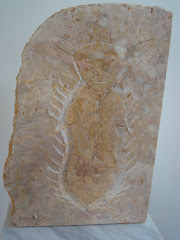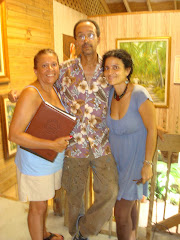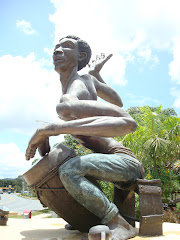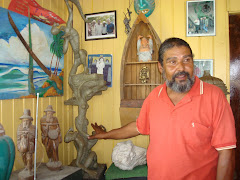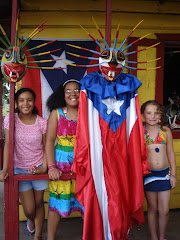October 25, 2008
Chicago Foundation for Education - Fund For Teachers
I want to extend a special thank-you to Gail Gold, my friend and colleague who encouraged me to dream. I want to give a warm appreciation to Carlos Flores for sharing his personal experiences and opening the doors to his world here and in Puerto Rico and a warm hug to my SOL sisters for being with me always in spirit. In addition, I want to dedicate this to my parents, Mom for accepting me with all my flaws and to my father who died in 1976 leaving behind a legacy of pride in self through culture.
Join me as I recount the personal narratives and lived experiences of Puerto Ricans who have been influenced by their African heritage.
August 30, 2008
Interview with David Aponte Resto

High on a hill lives an extraordinary artist that allows his spirit to influence his work. He identifies his work as revelations that come to him through dreams and meditation; serving as the medium to the creation lead on by a higher power. Inspired at a young age to develop this calling he found Arthur Schaumburg to be a strong influence and gives him credence whenever possible. He feels that in all of his lives he has had a strong connection to expressions of art and feels a responsibility to bring it to the public as each piece evolves into a new perspective of his current consciousness. Self-taught in sculpture, his workshop is his power his person.
David’s African-Caribbean connection is reflected by rediscovering the past and he brings it to the present so that it’s never denied the existence it rightly deserves. He is motivated to get the spirit of his trilogy of roots in three dimensions since they all have a story to tell. One such piece that was most memorable to him was “Dona Maria” created while his brother was hospitalized at a time when AIDS was not yet identified. “Dona Maria” reflects the free love mothers give, unconditional acceptance.
David feels that the pieces, which will be the most difficult for him to create, are the ones not yet done. Apparent in his current pieces are the generously proportioned hands and feet that he feels represent the ability Puerto Ricans have in achieving whatever their dreams may be and to stand tall in that belief. He generously allowed me to view his newest piece which has yet to be unveiled and is titled “El Cacique Naguabo” here he captured the essence of water which represents the spiritual needs the earth as well as the inhabitants need to survive and flourish to our greatest capacity.
One perspective David felt strongly about was to leave a legacy behind, to be a link to the old then to the present. He wants to be good to his gift so it will live on long after he is gone; to have people see his work and say “Damn”
The works of David Aponte Resto can be found in Puerto Rico, New York, and Texas. For further insight check out a few websites that feature David’s life and work: http://www.puertoricanpower.net/
my.opera.comhttp://www.artistasdelatierra.com/artistas/DavidAponthttp://www.voodoochilli.net/showArtist.php?artistID=5263
You can contact David at: davidelindio@yahoo.com or
drop him a line at PMB 054 Box 760 Rio Blanco, Puerto Rico 00744
David Aponte Resto is currently a resident of Naguabo living in the district of Rio Blanco. Naguabo is known as "El Pueblo de los Enchumbaos" (the town of the soaked ones). Naguabo was founded in July 15, 1821. Derives its name from a local Indian Chief Naguabo.
August 26, 2008
Interview with David Perez Montes

August of 2008 in Caguas, Puerto Rico
A lifetime of working in the stone business in all facets in California, Arizona, Texas and the Virgin Islands, David Perez Montes returned to his beloved Puerto Rico where it all began. As is typical on the island, David is a part of a very closely-knit family. With parents, brothers and sisters as his neighbors he has a network of support that surpasses any he had when abroad.
As we walk toward the home he built next to his parent’s home we continue through a walkway leading under his home, this area renders a wide expanse of open space with pillars holding up his house. It is in this space that David at all hours of the day and night turns stone into art. Although he does not limit his talents to art pieces, he applies an artistic touch to the stone counters, sinks and tables he creates. Having at his disposal an array of ocean and leaf impressions, he meticulously recreates them through carvings in his one of a kind artwork.
As we go back up the walkway he explains how some of his pieces by virtue of their weight are permanently displayed. One such piece is a totem like pole of stone depicting the engraved faces of the three kings. He smiles and claims that art is not seasonal, the piece stays there all year long. The stairs leading up to his home are also made of stone with the edges kept in their natural state of design and continue through to his front door. Before entering he points to a design of a small boy and how the piece were made especially for his son. In entering the home you are greeted by Gallery style pieces of faces, bust of horses along with fish impressions that seem fossilized on the stone, leaf impressions that will never wither up and die and the recreation of Taino petroglifo symbols. However, a common impression begins to emerge as you see sail boats in different sizes and styles, as he permanently engraved his passion for sailing. David pointed out how each stone in it has beauty and he works with it respecting its natural state. The various names of each stone formation flows from his mouth as he demonstrates an intimate knowledge of each piece expressing how coral is his favorite since it is native to the island. As artistic guides he uses the islands natural state, for symbols indigenous to the island he refers to the cultural writings of Nelson Rafael Collazo, where each symbol is identified and it’s meaning expressed. David maintains the importance of using the islands natural stone resources with respect and to also let those resources guide one when making creations, as each piece develops it’s own unique characteristics.
One perspective that David Perez Montes would like to convey is his desire to be true to the history of the island and to respect the resources it provides. The need to keep the culture alive and present to the public is important to him as he explains “Our children have to be exposed to our culture, the Tainos, Africans, Los Jibaros, our history and to begin this in the home; every generation has a responsibility to ensure that it continues to be a part of their life. It’s also important that they understand we have a lot of different characteristics that make up what we are today, it doesn’t matter how artisan’s express it as long as it’s not forgotten.”
At the time of this writing David is currently one of many artisan that is working toward organizing their talents formally in the town of Caguas, Puerto Rico. You can write to him at HC-11 Box 47678 Caguas, Puerto Rico 00725
The 3 Kings (Epiphany) is celebrated in Puerto Rico on January 6. Traditionally the children take a small box and fill it with straw; it’s then placed under their beds on the eve of 3 kings. The straw is for the camels that bring the 3 kings to their home bearing gifts for the children or as they say young at heart..
Antonio M. Folch Torres

August of 2008 in San Juan, Puerto Rico
It’s early afternoon, with a piragua in hand I watch as a crowd begins to gather around and page after page they are captured by the surrealism of Antonio M. Folch Torres. Patiently I wait for the crowd to thin out but standing there I hear words of innovative, modern designs, cultural wonders and my favorite, fantasy realized.
Anthony, a second year student at Escuela Arte Plástica is one of many vendors in the Old San Juan sector of Puerto Rico. At an early age of 10 he found himself on a journey trying to seek a style he can call his own. Inspired by the works of Matisse, Dahli, Picasso, Rafael Tufino and Heriberto Gonzalez Sanchez, he found his way to his own artistic destiny. Antonio displays a modern edge to his cultural ties of the past, weaving in African and Taino inspirations through new age technology.
The graphic designs are bold in color intertwining symbols of his past. His expressions of the island’s history are given a new facelift that appeals to the very young as well as the not so young. To the novice, he explains in detail how the Puerto Rican flag alongside the flag of Lares is instrumental to our history and anchors it to the Taino symbol for the sun, most notably identified as Sol de Jayuya, he expresses how our past is coming alive from the pages of a book. Musical instruments are interlaced with the faces of African decent under the Taino sun showing evidence of his inventive approach he calls his own. He feels it’s important to keep the generation connected and if he can do that through his art he feels complete. His designs range from simplistic to a valiant futuristic twist of awe and to this day he claims that each piece keeps him wondering how he was able to bring alive that imagery to portray his message.
One perspective that Antonio M. Folch wanted to share was his innovative approach to bringing the islands culture to the present, connecting the generations. He expresses how every piece is new to him as he approaches history with a fresh perspective applying a new method that appeals to a vast number of locals as well as tourist.
Anthony M Folch has a web site where you can see his artwork which can be purchased on canvas, in poster as well as on T-Shirts at his website The World of Bagua Boriken at http://baguaboriken.com/ but due to the inconsistencies of Internet on the island he welcomes your viewing his work then phone your order in at
787-717-3564
Escuela de Artes Plásticas de Puerto RicoBarrio Ballaja Campo Del MorroSan Juan, PR 00902-1112p. 787-729-0007 Escuela de Artes Plásticas de Puerto Rico is unique in its study options. Furthermore, it is part of an urban setting, large city (250,000 – 499,999) and Commuter campus. The school’s size is approximately three hundred and forty-one degree-seeking undergrads and fifty-nine first-time degree-seeking freshmen. Escuela de Artes Plásticas de Puerto Rico offers Bachelor’s degrees. In addition, the student body consists of seven percent part-time students, thirty-four percent women, sixty-six percent men and one hundred percent Hispanic.
August 25, 2008
Family Traditions Honored: Los Ayalas


August of 2008 in Loiza, Puerto Rico
In the town of Loíza traditional activities honoring St. James the Apostle show a mix of indigenous, African and Hispanic cultures, but the African elements are the most prominent. It’s in this town where you can experience an important aspect; the Castor Ayala Museum & Shop where generations of Ayala’s continue to carry on the tradition of mask making; displayed are the brightly colored mask a trademark of the family and the pride of Loiza. The family operated business continues to carry on the craft in the same location where their grandparents began the tradition of these vejigantes indigenous to the town. The craft of making mask out of coconuts husk has evolved over time but the pride of completion and wearing them for the various festivities continues to be a strong element that is destined to always be a part of Puerto Rico.
The Vejigante symbolizes the Moslems that Saint James fought with in Spain. The Vejigante costume is of bright colors and consists of a large overall with wide sleeves that once you open your arms, simulates wings. However, the most important part of the costume is the mask, which is made of coconut husk, with bamboo strips for teeth and is the most prominent craft that carries a long history of traditional Afro-Puerto Rican art.
Inside the small dwelling you will see how the Vejigante mask has evolved from simplicity to bold colors. Posters and plaques of recognition for their cultural contributions to the island are strategically placed for visitors to view. The walls, which are under construction for conservation, are actual murals painted by the elder Ayala and are a testimony to the depth of his talents as he captured the flamboyant tree and coconut palm trees, so much a part of coastal Puerto Rico where Loiza is located.
Although the Ayalas’s are famous for their Vejigante mask, they are also known throughout the island and abroad for their strong performances of the Bomba. Mask-maker Castor Ayala put together the Ballet Folklorico Hermanos Ayala, a folk music and dance troupe that continues to be a central force of entertainment during the Festival of St. James the Apostle. Bomba is a rhythm that is unique to the island of Puerto Rico and it claims its origins from the ancestors of the enslaved African peoples of this Spanish held colony. A focal piece of Bomba is the female dancer; she uses her skirts, hip and shoulder movements to entice the drummer into following her leads, however one drum dominates and it’s that drum that is beating to the dancers move. This tradition has been carried on for over 300 years with very little change and will always be an important part of the islands heritage.
For your listening pleasure you can purchase & hear clips of their music at http://www.hermanoayala.calabashmusic.com/ or write to rayala@coqui.net to order directly from them music and videos.
Loíza was proclaimed a town officially in 1719 and named in honor of Yuisa or Luisa, one of the women caciques on the island when the Spanish conquerors arrived. Loiza is also known as "La Capital de la Tradicion"- "The Capital of Traditions"- for its "bomba" music, traditional Taíno and African dishes, artisanry, and distinct culture. Loiza is home to such celebrities as the "Hermanos Ayala", Samuel Lind, Daniel Lind, DJ Eliel, DJ Tito, La Sista, Abrante, Mangani, etc. and many artists have roots in Loiza like Daddy Yankee (his father is known as El Negro from "Los Hermanos Ayala", Ramon Ayala),Tego Calderon, Don Omar, Lennox from "Zion y Lennox", Mackie from "Mackie y Yaga" and many others.
Samuel Lind desde Puerto Rico

August of 2008 in Loiza, Puerto Rico
Walking down a narrow street I hear the beat of African drums, my destination the legendary home and studio of Samuel Lind. As I knock on the wooden door I am taken back at how his home is unique and true to the artist eyes embracing all who enter.
Growing up in the town of Loiza, which the Nigerian slaves of the Yoruba tribe settled in the 16th century; Samuel Lind proudly embraces his heritage and demonstrates this with honor and privilege through his art pieces. As a child he was encouraged to pursue this talent by his elementary teacher Maestra Rosa. He was very moved that he had accidentally ran into her and the opportunity presented itself so that he can thank her personally for her words of encouragement as well as the supplies she provided him with. He smiles as he recounts how as a child he would sneak off from school and instead get on the bus and go to the Art school in San Juan which is approximately 20 miles away. There he would observe and soak in what is today his passion. He points to a painting titles “El Caminito” and explains that the man in that picture is his Uncle who was like a father to him as well as a giving him a lot of inspiration. So strong is his connection to that era he now uses it as the background design for his business cards and claims that it is one piece that will never leave his home. He speaks humbly of his mother and although money was scarce he recalls many special moments with her.
Samuel feels that his art is the instrument that best describes who he is; it is his identity. His graphic designs depict the importance of culture and he infuses his African heritage in all of his work. Most evident of his African heritage are the works titled “La Fiesta de Loiza” (The Festival of Loiza) and his “Baile Bomba” (Bomba Dance) series. Musical masters inspired many of his art pieces; specifically Tite Curet Alonso who wrote a song based on the 3 kings.
Samuel Lind feels that through meditation he becomes inspired and when he writes about the works he validates their existence. In Loiza they depend on him to portray their spirit; in Puerto Rico he was one of the few chosen to do graphic series of cultural events because of his rich knowledge on how to convey messages through art. The movement of voluptuous hips, strong passion on the faces and a lively stride to the feet is a testament to his attention to details.
One perspective that Samuel Lind wants to convey is how historically art conveys a message, regardless of the medium used. There is a story that the artist is trying to tell the viewer. His vocation and responsibility is to bring to life the figures in his work, to show the passion of the dancer, to express anticipation and to do this well. His work draws the viewer in and inevitably leaves you wanting to see more.
Samuel Lind is a featured Guest Artist at http://www.studioporto.com/ also featured at http://www.elyunque.com/
Samuel Lind had gallery showings in N.C.A&T State University, Africa International House for the African Festival of the Arts, Washington Park Chicago, Cucas Gallery in Chicago, Illinois
You can write or contact Samuel Lind at loizano@prtc.net P.O. Box 527 Loiza, Puerto Rico 00772
Samuel Lind’s studio is in Loiza #187 directly across from artisan Ayala, The Master of Mask making, famous for mask indigenous to Loiza made of coconut husk.
Tite Curet Alonso wrote the song Las Caras Linda (De Mi Gente Negra) (The Beautiful Faces (Of My Black People) recorded by Ismael Rivera, is considered by many in the Puerto Rican community as a classic.
Interviews; Puerto Rican Artist Reflections

August 2008 in El Condado, Puerto Rico
Antonio Bróccoli Porto exemplifies how diverse Puerto Ricans ethnicity can be. With an educational background ranging from the University of fine arts in the USA, Puerto Rico and Italy, coupled with his love for the rich and diverse culture of Puerto Rico you have an anthology of creations uniquely his own. Nicknamed “El Italiano” by virtue of his name, his induction into the artisan community of Puerto Rico became a reality as he displayed works of integrity with sincerity portraying the islands cultural influences.
Encouraged by his parents to pursue his passion for art, Antonio in the barrios of New York immersed himself in the music and dance native to the Afro centric influences of Puerto Rico. Among his pieces that reflect his African roots to name a few are Flora, La Isla Tiene Tambo, El Baile de Loiza Aldea, his whole Bomba Plena collection. Although he pays tribute to his education he identifies more with his experiences in the Bronx, the execution of his work remains constant in his work as he interprets those experiences inspired by what he saw and felt portraying these senses through his art pieces. His work is cultural and folkloric while maintaining his individual style of painting and use of color. He incorporates the belief that “we are all creation of god and our traditions are of value for future generations to appreciate, my love for the rich and diverse culture of Puerto Rico motivates me to create”.
As part of his repertoire Antonio was featured as an artist in residence promoting the “Me Mask Project” where elementary students (K-4) of Bradford School in Montclair, N.J. were taught through art, music and literature to explore their uniqueness and cultural backgrounds to create a mask that will depict who they are. He emphasized the importance of interviewing family members, researching oral traditions and the cultural perspectives they bring to the community.
Art flows from Antonio’s soul and unique to this declaration is his transformation titled “Loiza a Osun” which is his interpretation of the masterpiece titled “Flaming June” by Lord Leighton, which hangs in the Ponce Museum of Puerto Rico. The transformation with intense detail and imagery indigenous to a Caribbean Dancer of Bomba from Loiza is a testament to the artist portrayal to be remembered for his expressions of beauty and culture along with impressionable nobility of his love for Puerto Rico.
Antonio Broccoli Porto has a web site with a wealth of information of his family, works and featured pieces around the world, as well as special recipes and honorary guests. In viewing his site you will be transformed into a world of diversity and knowledge that has embraced his journey from the past to the present; porto@studioporto.com or you can drop him a line at his home and studio: Art Studio Porto 332 Vales de Torrimar Penthouse Studio F-308, Guaynabo, Puerto Rico 00966
The Mask Project: The project also provided its participants with career awareness and with authentic activities that bring students closer to possible career choices in the fields of art, communication and teaching. If you are interested in bringing this type of workshop to your local school please have the school administration contact the artist at
July 1, 2008
Educational Insight


To study African slavery and its influence in the Caribbean through interviews, indigenous art, dance and works of literature
My family migrated to the United States when I was 3 years old and family traditions provided me with a safe haven to maintain my native language. My educational experiences through classrooms and workshops have definitely enriched my capacity to teach effectively. In addition, my personal experience as a native Spanish speaker has also prepared me to assist those students new to our country and the mainstream culture, where currently more than 50% of my students are Spanish dominant.
I’ve always held a fond love for reading and this habit continues to this day in and out of the classroom. All of my educational experiences have been in a traditional classroom; however, the desire to learn in a nontraditional classroom is something I have always hoped to experience.
Through this grant I had the unique opportunity of speaking and interacting with this community of artists, an experience that will provide me with an understanding that goes beyond the pages of a book. To be submerged within their culture and become an integral part of their world was an experience that could only build on my ability to be a better teacher as I transfer this passion of learning on to my students.
As an educator I have always emphasized the importance of higher learning seeking creative ways to find information. This grant provided me with the resources to make a difference for myself as well as my students. As teachers we must continuously strive to be positive role models in the community. By spending my summer wearing the shoes of a learner, I will give reverence to the art of education. This experience will pay homage to the statement that: “learning is a life long process that can be exciting and rewarding.”
Through the perseverance of my family, I was given an opportunity to develop academically yet maintaining my individuality. I learned by discovery, which fostered independent thinking. Children should be given the opportunity to experience and celebrate who they are and what they can become. Learn concepts that are dictated by the curriculum yet afford the student with opportunities to expand creatively on the topics that interest them in their lives. Experience a positive educational experience that will motivate them toward self-initiated experiences. Through this project I can continue to offer students the opportunity of a child-centered learning environment and give them a reason to get to school early and leave late.
June 29, 2008
Chicago Foundation for Education http://www.cfegrants.org/
Fund for Teachers http://www.fundforteachers.org/
Carlos Flores cflores49@sbcglobal.net
Antonio Broccoli Porto porto@studioporto.com
Samuel Lind (loizano@prtc.net)
Raul Ayala rayala@caribe.net
Carlos Aponte Resto
Here are a few websites that feature David’s work:
my.opera.com
http://www.artistasdelatierra.com/
http://www.voodoochilli.net/
Museo de Las Americas in Puerto Rico
Loiza Township in Puerto Rico
Ponce Township in Puerto Rico
Caguas Township in Puerto Rico

